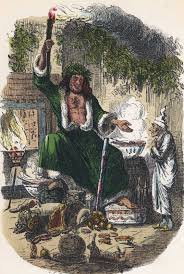Christmas’s fungal roots
By Daniel Butler, Author and forager
There is a popular urban myth that our familiar Father Christmas was created by a Coca Cola 1931 ad campaign where a beaming, ruddy-cheeked, bearded old man, dressed in the company’s colours, brandishes a glass filled with the fizzing brown liquid.
This is, of course, marketing bullshit peddled by the soft drinks giant. His classic red and white costume predates this advert by at least half-a-century. Certainly until then he was most commonly dressed in green which probably has pagan echoes (eg Gawain and the Green Knight). He started to be regularly dressed in scarlet in the second half of the 19th century, however. So while George Cruikshank depicts him in green in A Christmas Carol (1843), soon after he was beginning to be dressed in scarlet and by the First World War an American company, White Rock Beverages, was selling water and ginger ale with a ‘modern’ Father Christmas.
But for foragers there is a more interesting seasonal fungal connection. Fly agaric, the classic ‘toadstool’, contains hallucinogenic compounds – most notably ibotenic acid. Unfortunately this is extremely bitter and can give a horrible hangover but it readily breaks down into the more acceptable muscimol.
Reindeer-herding shamens used it to communicate with the spirit world, helped by the discovery that drying changes much of the acid to muscimol. This resilient chemical is also largely unaffected by liver and kidney processes. In other words, it leaves the mammalian body almost as pokey as it entered. As a result, the urine from someone – or something – which has consumed fly agaric is purified but still hallucinogenic.
For many centuries fly agaric would feature in Siberian ‘mushroom feasts’. In the early 18th century a Swedish colonel, Philip von Strahlenberg, described how the poor would wait outside the halls with wooden bowls poised. When the revellers emerged to relieve themselves, they would catch the urine and drink it: ‘greedily, as having still some of the virtue of the mushroom in it, and by this way they also get drunk’.
Fly Agaric (Amanita muscaria)
Photo: Author’s own
Reindeer also love it, actively seeking out and wolfing down mushrooms amid the birch scrub. These have the same effect on them as they do on humans and an alert herder could collect the golden liquid in a flask for later use.
When the first serious snows begin to fall in November, the nomadic way of life grinds to a halt as the herdsmen bunker down for the winter. They do this in tepee-like tents which stay put for the next seven or eight months. After a few weeks the snow builds up around the exterior and the only way in and out is through the smoke hole.
As nights get longer and longer, there is little else to do but drink reindeer pee and enjoy the traditional celebrations around the winter solstice. The herdsmen sit in the gloom, high on muscimol and imagine reindeer flying across the sky, their dreams are only interrupted by the arrival of neighbours who arrive via the smoke hole with presents for the children. Some people therefore suggest the mushroom is the source of the red and white of Santa’s tunic. It may also explain why some European languages call getting drunk as being ‘mushroomed’.
All this, of course, is no more than educated conjecture, the connection between fly agaric and classic children’s literature is much more clear-cut.
It is not known if the Oxford mathematician, Charles Dodgson (who we know as Lewis Carroll) actually tried fly agaric, but he certainly knew it could distort perspective because he reviewed a book by a fellow don, Mordecai Cooke, on its hallucinogenic properties. The latter wrote that consumption led to:
erroneous impressions of size and distance are common occurrences . . . a straw lying in the middle of the road becomes a formidable object, to overcome which a leap is taken sufficient to clear a barrel of ale, or the prostrate trunk of a British oak.
Certainly when Sir John Tenniel illustrated Alice’s Adventures in Wonderland, it was with a caterpillar smoking a hookah while sitting on a mushroom which is clearly a fly agaric. The insect tells her one side of the fungus will make her grow smaller, the other taller. Tom Petty clearly took inspiration for this when creating his mushroom-inspired video for Don’t Come Around Here No More (in reality the song was actually spawned by a drunken night in Stevie Nicks’ house).



